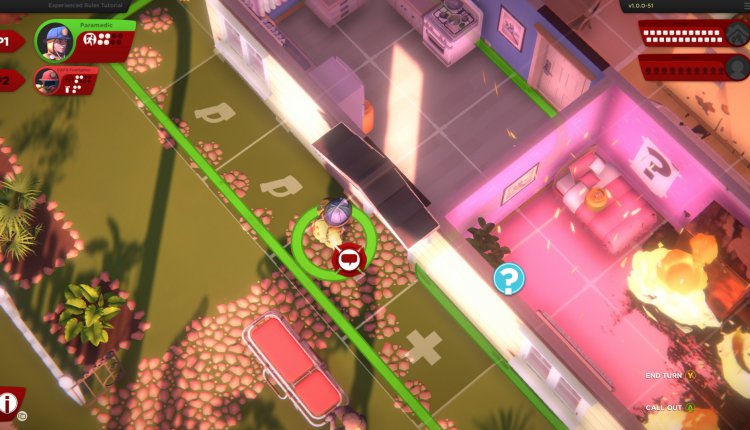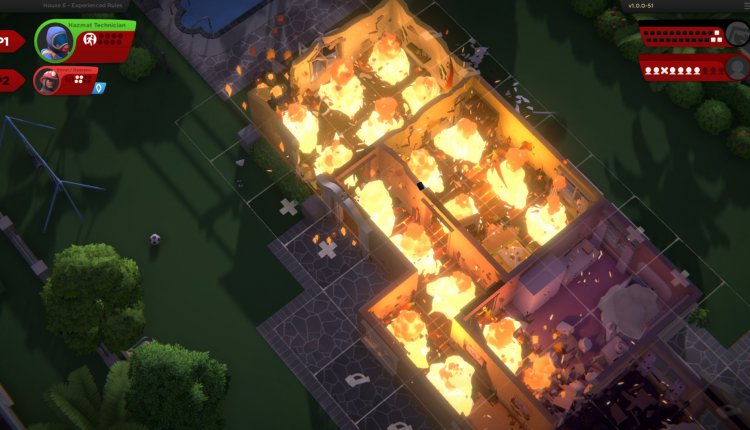Flash Point is a turn-based, single-screen, local co-op game about battling flames, breaking through walls and saving the incapacitated, disaster-prone residents of a world where every house is on fire. You and your co-op partners are cast in the role of heroic firefighters with one goal: save a set number of lives and get out before the raging inferno causes the house to collapse into a pile of rubble.
The digital incarnation of a popular board game I’ve never played, Flash Point adheres quite closely to the form of its physical predecessor, which is the long-winded way of saying it plays exactly like a board game, but with the addition of sound, colourful graphics, earth-shaking explosions, and some cute animations thrown in. Each round begins with a fixed, overhead position showing the full interior of a one-level suburban home, its various entrances, and the starting locations of the smoke and fire. Possible victims in need of rescue are shown as blue question marks, ready to be investigated. Players first choose where to place their firefighters outside the home and then the rescue operation begins.
Each player’s turn is determined by a set number of action points and a highlighted perimeter of possible movement on a grid. Between each turn the fire gradually — and occasionally not so gradually — expands its territory. Darting randomly between rooms, the fire takes the form of a floating, zigzagging ember. Think a pyrotechnic Tinkerbell bent on causing chaos and destruction. The ember landing on a not-yet-flaming square produces smoke, while its landing on smoke produces fire, and its landing on fire creates the possibility of an explosion which deteriorates the building’s structural integrity — shown by a collection of points in the upper right hand corner of the screen that slowly ticks down as the house takes more damage.
The game offers two ways to play: Family or Experienced modes. Family mode is the game cut down to its essentials. Here firefighters are only differentiated by color and all have the same set of possible actions, determined by the firefighter’s location. Standing next to doors allows them to be opened or closed. Standing next to or on fire or smoke allows the player to use their fire extinguisher, turning one square of flame into smoke, or dissipating the smoke itself altogether. Chopping through a wall to create a new entrance to any room is always an option but it takes extra action points and damages the home’s structural integrity.
Blue question marks are revealed only when the firefighter is standing on the square they occupy. They are always either a collapsed human being in need of rescue, or an alarm clock that has successfully tricked the player into investigating it. Once a firefighter finds someone to rescue they have the option to hook them onto their belt and pull them to safety. It is possible to walk through flames and smoke, but not when dragging victims to safety. Players also have the option to call out, which generates additional blue question marks to investigate.

Experienced mode complicates the game considerably by adding two vehicles, eight specialists, hazardous materials and hotspots. The vehicles are an ambulance gurney and a fire truck water hose basket. Both are placed at the start of the game by the players and neither can enter the house. The gurney is required to rescue victims and also functions as a swift way for a firefighter in a hurry to reach a different entrance. The basket adds the ability for players to cool down flaming areas with a blast of water but has low accuracy. The different firefighter classes add lots of variety to available actions. Some are able to haul out hazardous material that is prone to extra big explosions. Some are medics able to resuscitate victims without a gurney. The fire chief even has the ability to give his action points to another player, just like a good captain would.
The added complexity of Experienced is initially enjoyable but after several rounds of playing the game you might find yourself, like me, wishing for more strategic possibilities, for more planned tactical manoeuvring between co-op partners. Flash Point is very much a digitalised board game but its PC incarnation left me feeling like I had caught a glimpse of something that could have developed further into something less dependant on the number of players you have alongside you, and instead more focused on deploying combinations of firefighter classes to overcome challenging fires and hazards.
There are other issues too. The sheer chance of game, something easier to accept in a physical game with rolled die or shuffled cards, can seem nonsensical and even unfair at times when presented on a screen. For example, when a blue question mark suddenly spawns in a space where you were just standing or in a room that you had already walked through. Other smaller details also stand out. The gurney, for example, is required to rescue fire victims, but once brought out of the house they will simply run away to safety, never touching it. Also, the number of people to save in any house to achieve victory is generally seven. But after saving the first couple people — all with different last names — you start to wonder how all of these people know each other and how they could have ended up in this situation.
Like many board games, Flash Point is most fun with more players. Try playing this solo and you could find yourself dialling 911 with a co-op partner emergency. But assemble 2-4 friends around your screen and there are a few hours of fun to be found and an original idea which is also free of combat and killing. In a world where it often feels like everything is on fire, it’s nice to sit down and play something that allows you to walk through flames.
Flash Point is available now for PC, Mac & Linux.
Love multiplayer games which aren’t violent or sports-related? Why not check out these ten?

Comments are closed.